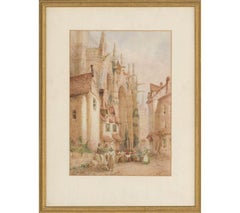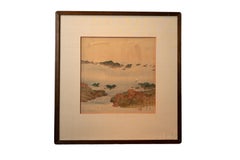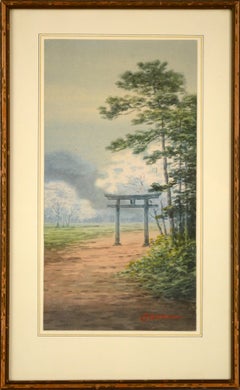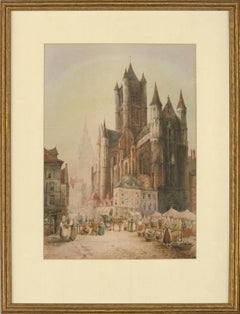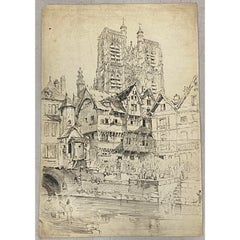Samuel Gillespie Prout Art
to
1
1
Overall Width
to
Overall Height
to
1
1
1
1
1
1
1
10,025
2,754
1,379
1,375
1
Artist: Samuel Gillespie Prout
Samuel Gillespie Prout (1822-1911) - Framed Watercolour, Market Day at Antwerp
By Samuel Gillespie Prout
Located in Corsham, GB
A very fine 19th century watercolour by well listed artist Samuel Gillespie Prout (1822-1911). Depicting a busy market day scene in Antwerp. Well presented in a modern gilt effect fr...
Category
19th Century Samuel Gillespie Prout Art
Materials
Watercolor
Related Items
'Chinese Mountain Scene, ' by Unknown, Watercolor on Silk Painting
Located in Oklahoma City, OK
This framed 24" x 23" watercolor on silk by an Unknown Chinese artist depicts a coastal mountain landscape. This work features several mountain clus...
Category
Late 19th Century Other Art Style Samuel Gillespie Prout Art
Materials
Silk, Watercolor
$960 Sale Price
20% Off
H 24 in W 23 in D 0.75 in
Early 20th Century Japanese Landscape Watercolor with Torii Gate
Located in Soquel, CA
Early 20th Century Japanese Landscape Watercolor with Torii Gate
Beautiful early 20th century Japanese landscape watercolor featuring a torii gate by Shumi...
Category
Early 20th Century Impressionist Samuel Gillespie Prout Art
Materials
Paper, Watercolor
$920 Sale Price
20% Off
H 17 in W 9.75 in D 0.25 in
'Landscape' by Joseph Fred-Perry Rendell, Watercolor Painting
Located in Oklahoma City, OK
This framed 14.25" x 17" watercolor by British artist Joseph Fred-Percy Rendell features a quiet landscape of rolling hills among a cluster of dense white clouds in a summer blue sky...
Category
Early 20th Century Realist Samuel Gillespie Prout Art
Materials
Watercolor
Joseph Fred-Percy Rendell'Landscape' by Joseph Fred-Perry Rendell, Watercolor Painting, early 20th c
$400 Sale Price
20% Off
H 14.25 in W 17 in D 0.75 in
WPA 1940s Framed Figurative Village Landscape with Figures, Houses & Mountains
By Charles Ragland Bunnell
Located in Denver, CO
This evocative watercolor on paper painting, titled The Way War First Comes (1940), was created by noted American artist Charles Ragland Bunnell (1897-1968) during the Depression era...
Category
1940s American Modern Samuel Gillespie Prout Art
Materials
Watercolor
$4,950 Sale Price
40% Off
H 26 in W 35.5 in D 0.5 in
Lake landscape
Located in Genève, GE
Work on paper
This painting depicts a dynamic harbor under a stormy sky. The artist uses energetic brushstrokes and a palette dominated by deep blues and ochres, giving the scene a d...
Category
1970s Expressionist Samuel Gillespie Prout Art
Materials
Gouache
St. Peter's Basilica from the Edge of the City - Roman Lansdcape
Located in Soquel, CA
St. Peter's Basilica from the Edge of the City - Roman Lansdcape
Lush watercolor of a sunset behind St. Peter's Basilica by Gaetano Facciola (Italian, 1868-1949). From a road at the edge of town...
Category
Early 20th Century Impressionist Samuel Gillespie Prout Art
Materials
Paper, Watercolor
Gaetano FacciolaSt. Peter's Basilica from the Edge of the City - Roman Lansdcape, early 20th Century
$520 Sale Price
20% Off
H 10.75 in W 18.5 in D 0.75 in
Original Winter Trees Landscape Watercolor - Rocky Mountains, Early 20th Century
By Charles Partridge Adams
Located in Denver, CO
This original early 20th-century watercolor is by Charles Partridge Adams (1858–1942), a celebrated American artist known for his exceptional depictions of the Colorado landscape and...
Category
Early 20th Century American Impressionist Samuel Gillespie Prout Art
Materials
Watercolor
$2,450
H 21.5 in W 27.75 in D 1.5 in
L'Ile des Oiseaux by Paulémile Pissarro - Landscape watercolour
By Paul Emile Pissarro
Located in London, GB
L'Ile des Oiseaux by Paulémile Pissarro (1884-1972)
Watercolour and charcoal on paper
23 x 31 cm (9 x 12 ¹/₄ inches)
Signed lower right, Paulémile Pissarro
Provenance
Private collec...
Category
20th Century Post-Impressionist Samuel Gillespie Prout Art
Materials
Paper, Ink, Watercolor
$4,800
H 9.06 in W 12.21 in
Lush Palm Bushes, Botanical Diptych, Still Life in Blue Tones, Tropical Style
By Kind of Cyan
Located in Barcelona, ES
This is an exclusive handprinted limited edition cyanotype.
"Lush Palm Bushes" is a gorgeous original cyanotype diptych showing gorgeous tropical palm leaves.
Details:
+ Title: Lu...
Category
2010s Art Deco Samuel Gillespie Prout Art
Materials
Watercolor, Lithograph
"San Anton Palace Malta" Early 20th Cent. Garden and Fountain Watercolor Russian
Located in Soquel, CA
A significant early 20th century landscape watercolor of the paradisical gardens at San Anton Palace in Attard, Malta by Nicholas Krasnoff, 1920 (Russian, 1864-1939). This beautiful piece is a wonderful example of the renowned Russian architect's prized watercolors, created while he was exiled to Malta in the early 1920's. Depicting a lush garden full of blooming, colorful flowers and a stately fountain at the San Anton Palace in Malta, one can see the deft hand and attention to detail rendered by the proficient artist and architect's hand.
Signed "N. Krasnoff" lower right. Titled and dated "Malta, St. Antonio 1920".
Unframed.
Measures 10.25"H x 14.25"W.
Right corner has a crease from being bent.
Nikolay Petrovich Krasnov, also known as Nicholas Krasnoff or Peter Nicholas Krasnoff, was a Russian Serbian architect and painter. He served as Chief Architect of Yalta, Crimea (1887-1899). From 1922 he lived and worked in the Kingdom of Yugoslavia, and was a key figure in the architectural development of Belgrade. Attending the Moscow School of Painting, Sculpture and Architecture in 1876, aged 12. As a young artist he received patronage from Sergey Tretyakov, brother of the founder of Moscow's Tretyakov Gallery, and entrepreneur Petar Gubonyin.
In 1887 Krasnov became Chief Architect in Yalta. At the age of 23, Krasnov had large responsibility for the rapid growth of the city. He expanded the promenade, which by 1913 became the city's main street, before creating a new city plan in 1889 (including a new sewer system, planning regulations, new streets, prevention of unregulated construction, a school and children's hospital, and the construction of the Pushkin Boulevard). Two concrete bridges were built over the river, and the embankment strengthened. Krasnov also ran a private practice in Yalta until 1911. Among his most famous work is the Livadia Palace, later the location of the 1945 Yalta Conference. Designed over 60 buildings in Crimea, blending a modernist style with local traditions. Also of note: Dulber Palace, Koreiz (1895-97), Alexander Nevsky Cathedral, Yalta (1902), Yusupov Palace, Koreiz (1909), Kokkoz Jami Mosque, Sokolyne (1910).
In 1913, he presented a collection of illustrations he had produced of his works to the Saint Petersburg Academy of Arts, where he held the title of academician. An opponent of the Russian Revolution, he left Yalta with his family in 1919 for Malta, alongside the Dowager Empress Marie Feodorovna, sister of Queen Alexandra, and over 600 members of the Russian aristocracy. Nikolay was in a group housed in the empty Villa St Ignatius, which had been a Jesuit college and then a hospital during World War I. To earn money, Nikolay painted many scenes of Malta, signing his paintings as N. Krasnoff. He is known as Nicholas Krasnoff in Malta. In May 2016 MaltaPost issued a commemorative set of stamps in his honor.
In 1922 Krasnov moved to Belgrade, then part of the Kingdom of Yugoslavia, where he became head of the Department of Monumental Architectural Developments and Monuments. His building designs in Serbia number around 60, and were created under the name Nikola Krasnov, as a mark of respect to his adopted homeland.
His key works in Belgrade include: Ministry of Forestry building (now Ministry of Foreign Affairs) (1923) which bears a memorial plaque...
Category
1920s Impressionist Samuel Gillespie Prout Art
Materials
Paper, Watercolor, Illustration Board
$12,400 Sale Price
20% Off
H 10.25 in W 14.25 in D 0.13 in
'Submerging, ' by Lisa Miceli, Watercolor on Paper Painting
By Lisa Miceli
Located in Oklahoma City, OK
This 15" x 22" watercolor on paper painting by Lisa Miceli depicts an imaginative abstracted landscape. This painting is part of the "latticeWorks Series."...
Category
2010s Abstract Samuel Gillespie Prout Art
Materials
Watercolor, Paper
$960 Sale Price
33% Off
H 15 in W 22 in
'Barn with Boat Dock, ' by Unknown, Ink and Watercolor Painting
Located in Oklahoma City, OK
This framed 22" x 29" ink and watercolor painting by an Unknown artist explores an abstracted landscape depicting a boat dock near a barn. In a neutral palette of browns, grays, and...
Category
Late 20th Century Contemporary Samuel Gillespie Prout Art
Materials
Ink, Watercolor
$400 Sale Price
20% Off
H 22 in W 29 in D 0.5 in
Previously Available Items
Samuel Gillespie Prout (1822-1911) - Watercolour, Saint Nicholas' Church, Ghent
By Samuel Gillespie Prout
Located in Corsham, GB
An exquisite Belgium street scene in Ghent, featuring the imposing St Nicholas' Church surrounded by market stalls and bustling figures. Painted by the highly collectable English pai...
Category
19th Century Samuel Gillespie Prout Art
Materials
Watercolor
Samuel Prout "Abbeville, France" Original Pen & Ink Drawing c.1819
By Samuel Gillespie Prout
Located in San Francisco, CA
Samuel Prout "Abbeville, France" Original Pen & Ink Drawing c.1819
Original drawing. Dimensions 13.5" wide x 19.25" high
No signature. "S. Prout" penciled on the back.
Fair antiqu...
Category
Early 19th Century Samuel Gillespie Prout Art
Materials
Ink, Pen
H 19.25 in W 13.5 in D 0.1 in
Samuel Gillespie Prout art for sale on 1stDibs.
Find a wide variety of authentic Samuel Gillespie Prout art available for sale on 1stDibs. You can also browse by medium to find art by Samuel Gillespie Prout in paint, watercolor and more. Not every interior allows for large Samuel Gillespie Prout art, so small editions measuring 18 inches across are available. Customers who are interested in this artist might also find the work of Muriel Archer, Louis Osman, and Gillie Cawthorne. Samuel Gillespie Prout art prices can differ depending upon medium, time period and other attributes. On 1stDibs, the price for these items starts at $715 and tops out at $884, while the average work can sell for $800.
